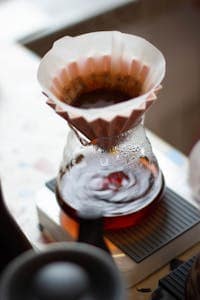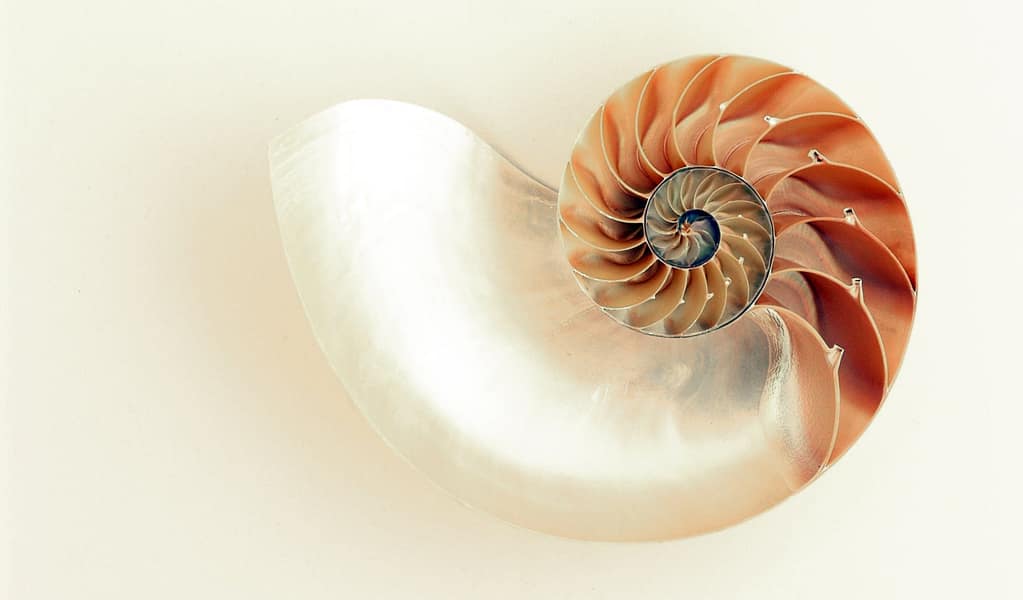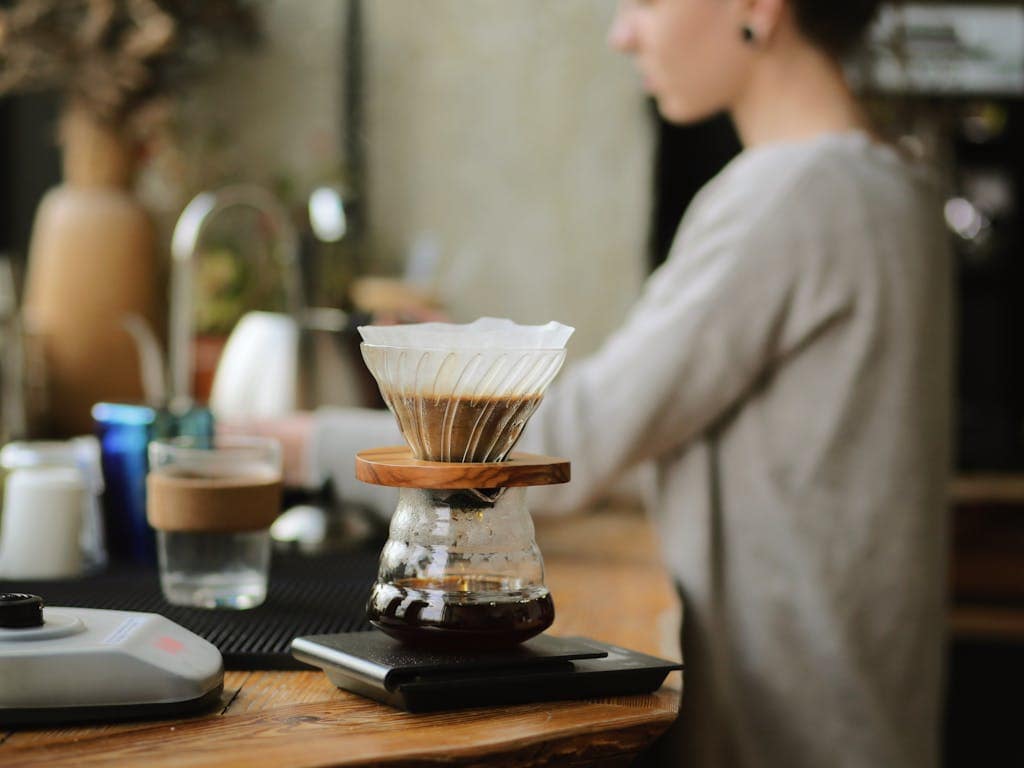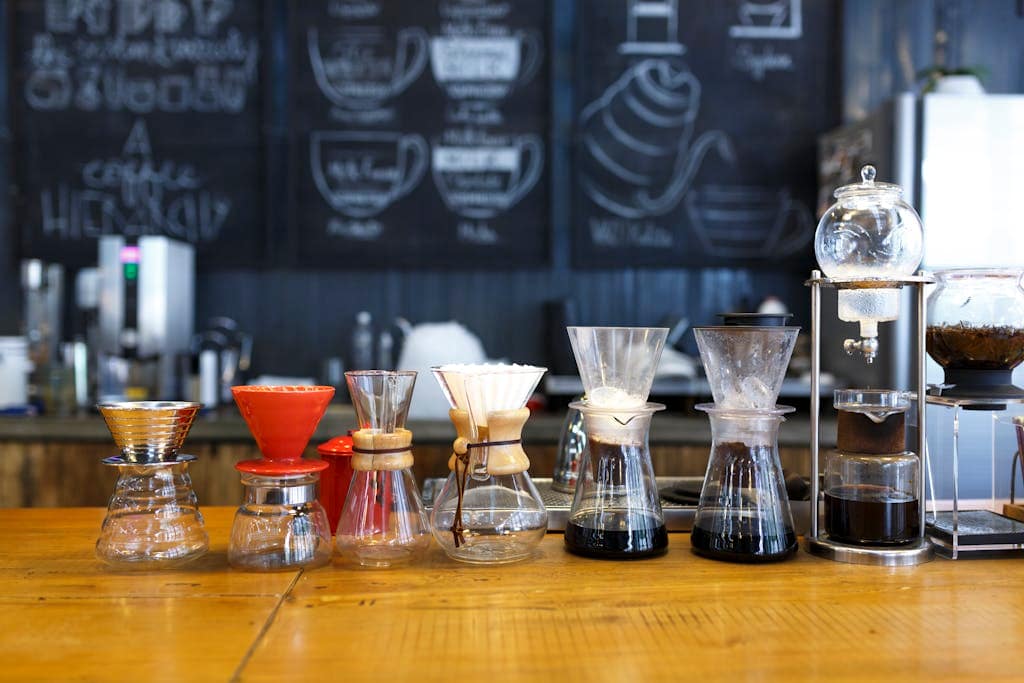
Ready to up your coffee game? Let’s get started!
Why the Pour Over Coffee Ratio Matters
The coffee-to-water ratio is crucial for making a stellar pour-over coffee. Imagine cooking with the right amount of salt or drawing with the perfect shade of color. Too little and it’s bland; too much and it’s overpowering. Here’s why nailing this ratio is game-changing.
Impact on Flavor
The ratio directly impacts the flavor of your coffee. If you’ve ever had a cup that tasted weak, like flavored water, it was probably too dilute. On the flip side, if it was too strong, it might’ve felt like licking a tree bark.
- Too Weak: A high coffee-to-water ratio, like 1:20, will result in a weak coffee. You’ll miss out on the rich flavors that make coffee exciting.
- Just Right: The sweet spot, usually between 1:15 and 1:17, gives you a balance of strength and flavor. It’s like hitting the perfect note in a song.
- Too Strong: A low ratio, like 1:12, can overpower your senses. It’s akin to an overpowering spice in a dish.
Getting the ratio right brings out the best in your beans. It’s like unlocking a treasure chest of flavors with each sip.
Consistency in Brewing
Consistency is the name of the game when it comes to brewing coffee. Imagine trying to bake a cake without measuring ingredients. Chaos, right? The same goes for coffee.
- Reliability: Using a consistent ratio helps you get the same great taste every time. No more guessing games.
- Precision: With tools like a digital scale, you can measure out coffee and water to the gram. It’s like being a coffee scientist.
- Ease of Tweaking: Once you find your ideal ratio, you can tweak it slightly to adjust for different beans or personal taste preferences.

Photo by Olha Ruskykh
Consistency means that your morning cup of joe can always be the perfect pick-me-up, making your day just a bit brighter.
Finding Your Perfect Ratio
Pour-over coffee is both an art and a science. The key to mastering it lies in discovering the perfect coffee-to-water ratio. This will make your cup of joe just right every time. Let’s explore how to find that perfect balance.
The Golden Ratio
Well, not the Golden Ratio shown if this image, but the same concept. The Golden Ratio for pour-over coffee is 1:16. This means using one gram of coffee for every 16 grams of water. Many coffee lovers start with this ratio because it offers a balanced flavor. It’s not too strong and not too weak—just right.
Using the Golden Ratio is like having a roadmap for your coffee journey. It sets you up for success and gives a clear starting point. Imagine it as the recipe for your favorite dish. You know it’s going to be good because the basics are solid.
Adjusting for Taste
Sometimes, the golden ratio might not hit the spot. Here’s where you can experiment. Everyone’s taste buds are different, and your perfect cup might need some tweaks.
- Stronger Coffee: If you like bold flavors, you can reduce the water. Try a ratio of 1:15 or even 1:14. This means more coffee per unit of water, intensifying the flavor.
- Milder Coffee: For a lighter brew, increase the water. Use a 1:17 or 1:18 ratio. This will dilute the coffee slightly, making it less intense.
Think of this like adjusting the seasoning in a dish. Too salty? Add more water. Too bland? Add a pinch more coffee. It’s all about finding what tastes best to you.
Finding your perfect ratio takes a bit of trial and error, but once you find it, every sip will be worth it. Keep experimenting and enjoy the process!
Commonly Recommended Ratios
Finding the perfect coffee-to-water ratio is key to brewing a delicious and satisfying pour-over coffee. Different ratios yield different flavors, so it’s essential to understand the three most common ones: 1:15, 1:16, and 1:17. Let’s break each down.
1:15 Ratio

Photo by Tim Douglas
The 1:15 ratio is ideal for those who love a strong cup of coffee. Here’s the scoop:
- Characteristics: This ratio uses one gram of coffee for every 15 grams of water. You get a robust, full-bodied brew with intense flavors.
- Flavor Profile: Expect a richer, more concentrated coffee experience. It’s like the espresso of the pour-over world—a punchy, bold taste that really wakes you up.
Imagine taking a bite of a dark chocolate bar; that’s the sensation you might get with a 1:15 ratio coffee. Perfect for people who love their coffee strong and uncompromising.
1:16 Ratio
The 1:16 ratio is often hailed as the “golden standard” for balanced coffee. It hits that sweet spot where you get the best of both worlds.
- Characteristics: With one gram of coffee for every 16 grams of water, this ratio provides a balanced cup that pleases most palates.
- Flavor Profile: This ratio brings out the nuanced flavors of the coffee beans. It’s not too strong or too weak—just right. Imagine the harmony of a symphony, where every note is perfectly balanced.
For many, this is the go-to ratio. It offers a smooth, rich experience that appeals to a broad audience. If you’re new to pour-over coffee, start here.
1:17 Ratio
Lastly, the 1:17 ratio is your best bet if you prefer a milder coffee. This ratio is about subtlety and smoothness.
- Characteristics: Here, one gram of coffee pairs with 17 grams of water. It’s a slightly lighter brew but still full of flavor.
- Flavor Profile: The result is a more delicate, refined coffee taste. Think of it like a watercolor painting—soft and easy on the senses, with a gentle complexity that reveals itself sip by sip.
If you like to sip your coffee slowly and savor the gentle nuances, the 1:17 ratio is perfect. It’s a great way to enjoy a relaxing morning cup without being overwhelmed by strong flavors.
In summary, each of these common ratios offers something unique. Whether you want a powerful kick, a balanced brew, or a gentle sip, there’s a perfect ratio for you. Experiment with these to find your ideal cup!
Tools and Equipment for Measuring Ratios
When it comes to mastering the coffee-to-water ratio for the perfect pour-over, using the right tools and equipment can make all the difference. Here are the essentials you’ll need to brew like a barista.
Digital Scales
Precision is key in the coffee world, and a digital scale is your best friend for that. Why? Because eyeballing it just doesn’t cut it. A digital scale allows you to measure your coffee and water down to the gram, ensuring consistency with every cup.
Why a Digital Scale is Important:
- Accuracy: Consistently great coffee every time.
- Control: Adjust your coffee-to-water ratio with ease.
- Professional Touch: Feel like a seasoned barista even in your own kitchen.
Think of a digital scale as your coffee GPS, guiding you to that perfect cup every time. Don’t leave it to chance; accuracy is your friend here.
Pour-Over Dripper
The pour-over dripper is where the magic happens. But did you know that the design of your dripper can greatly affect the outcome of your brew? Let’s break it down.
Types of Drippers:
- Conical Shape (e.g., Hario V60): Promotes a balanced extraction and is great for highlighting the subtle flavors.
- Flat-Bottomed (e.g., Kalita Wave): Ensures even extraction, providing a consistent taste with every brew.
- Wedge Shape (e.g., Bee House): Offers a middle ground, balancing between nuanced and even extraction.
Each design has its pros and cons, so experiment to find what satisfies your coffee cravings. The pour-over dripper is like your canvas, and the design impacts how your coffee “painting” turns out.
Grinders
If the digital scale is your GPS, then the grinder is your kitchen’s secret weapon. The grind size of your coffee beans can make or break your pour-over coffee. Here’s what you need to know.
Why Grind Size Matters:
- Surface Area: Finer grinds increase the surface area that comes in contact with water, affecting extraction.
- Consistency: A burr grinder provides uniform grinds, resulting in a balanced flavor.
- Freshness: Grinding your beans just before brewing ensures the freshest cup possible.
Using a quality grinder is like having a sharp knife in the kitchen – precise and essential. Whether you prefer a coarser grind for a milder brew or a fine grind for a bolder taste, the right grinder helps you achieve coffee perfection.
In summary, the right tools and equipment are crucial for nailing that perfect coffee-to-water ratio in your pour-over coffee. So, gear up, and let the brewing begin!
Step-by-Step Guide to Brewing with the Perfect Ratio
Brewing pour-over coffee is like creating a masterpiece. Every step is crucial to achieving that perfect cup. Let’s take a walk through the brewing process from start to finish. Follow these simple steps and you’ll be brewing like a pro in no time.
Preparing Your Equipment
Before you even think about pouring water, gather all the right tools. Just like a chef needs the perfect knife, your coffee equipment needs to be in top shape.
- Gather Your Tools: You’ll need a pour-over dripper, paper filter, kettle, digital scale, fresh coffee beans, and a grinder. Clean and ready means no weird flavors sneaking into your brew.
- Heat the Kettle: Fill your kettle with fresh water and heat it to around 200°F (93°C). This is the sweet spot for extracting those tasty coffee flavors.
- Rinse the Filter: Place the paper filter in your dripper and rinse it with hot water. This removes any papery taste and preheats your dripper and carafe.
Measuring Coffee and Water
The next step is crucial for that golden ratio. Proper measurement ensures that every cup tastes just right. Get good coffee beans! Check this article to help you devide what beans to get: Best Coffee Beans around the World
- Weigh the Coffee: Use your digital scale to measure the coffee beans. A good starting point is 25 grams of coffee for a 400-gram cup of water, giving you a 1:16 ratio.
- Grind the Coffee: Grind your beans to a medium-coarse texture, similar to sea salt. Too fine, and it’ll be bitter; too coarse, and it’ll taste weak.
- Measure the Water: Place your dripper on the scale and tare it. Slowly pour in 400 grams of hot water, aiming for precision.
The Pouring Technique
Now for the fun part! Pouring might seem simple, but there’s a method to this madness to ensure your coffee is evenly brewed.
- The Bloom: Start by pouring just enough water to cover the coffee grounds, about 50 grams. Let it sit for 30-45 seconds. This is the “bloom” and helps release gases for better extraction.
- Circular Pouring: Pour the rest of the water in a slow, circular motion, starting from the center and moving outward. This ensures even saturation and extraction.
- Wait and Enjoy: Let the coffee drip through the filter completely, usually taking about 3-4 minutes. Remove the dripper, pour your coffee into a cup, and savor the flavors.
Brewing with the perfect ratio is part science, part art. It’s all about precision and patience. Once you get the hang of it, you’ll find that perfect cup is always within reach.
Troubleshooting Common Issues
Even with the perfect ratio, sometimes things can go wrong. Don’t worry; it’s all part of the coffee adventure. Whether your pour-over coffee tastes weak or bitter, here are some common issues and how to fix them.
Weak Coffee
Weak coffee can be a real bummer, especially when you’re craving that rich, flavorful morning cup. Fortunately, a few adjustments can help.
- Adjust the Ratio: Try increasing the amount of coffee to water. If you’re using a 1:17 ratio, switch to 1:15. This should give you a bolder, stronger flavor.
- Change the Grind Size: The grind size of your coffee beans plays a big role in extraction. If your coffee is too weak, the grind might be too coarse. Adjust to a finer grind to increase surface area and enhance extraction. Think of it like using a sharper pencil for better detail in your drawing.
- Pouring Speed: Slow down your pour. A fast pour can result in under-extracted, weak coffee. Pouring slowly allows the water to fully saturate the grounds, extracting more flavor.
- Water Temperature: Make sure your water is hot enough, ideally around 200°F (93°C). Too cool, and your coffee won’t extract properly, leading to a weak taste.

Photo by Michael Burrows
Bitter Coffee
On the flip side, if your coffee tastes bitter, it’s like biting into a lemon—unpleasant and off-putting. Here’s how to dial back the bitterness:
- Tweak the Ratio: If your coffee is too bitter, you might be using too much coffee. Try a 1:17 or 1:18 ratio. This dilutes the coffee slightly, softening the bitter notes.
- Adjust Brewing Time: Over-extraction can cause bitterness. If your brew time is too long, reduce it. Aim for a total brew time of about 3-4 minutes. It’s like cooking pasta; too long in the water, and it turns mushy.
- Grind Coarser: If your grind is too fine, it can lead to over-extraction and bitterness. Switch to a coarser grind to balance the flavor.
- Control Water Temperature: Water that’s too hot can make coffee bitter. Stick to around 200°F (93°C). Think Goldilocks: not too hot, not too cold—just right.
If you follow these tips, your pour-over coffee should come out tasting fantastic every time. Don’t be afraid to experiment; finding the right balance is key to perfecting your brew.



